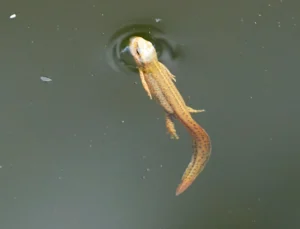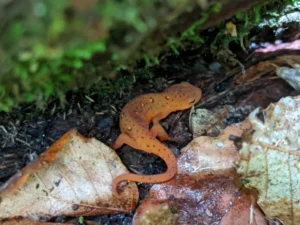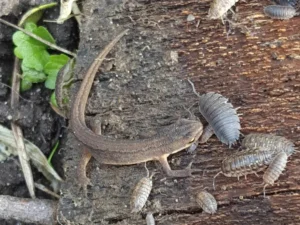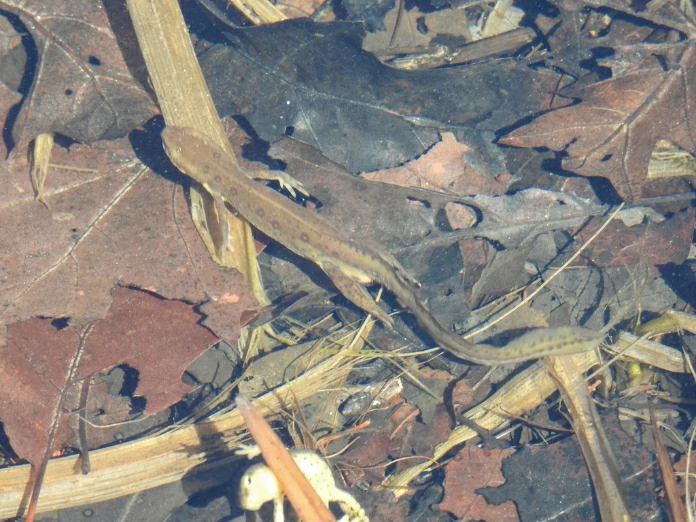Have you ever seen a small newt slipping through a pond or scurrying across wet leaves and wondered, “How fast can it really move?”
Newts aren’t very fast compared to bigger animals, but they move quickly enough to escape predators and hunt for food. In water, they can swim several inches per second.
On land, they crawl or wriggle steadily using their tails and limbs. Their speed changes depending on species, age, temperature, and the situation.
How Newts Move in Water
Water is where newts really shine. They’re amphibians, so swimming comes naturally. When a newt swims, it uses a mix of tail flicks and limb strokes.

Their long tails act like rudders, pushing against water to move forward.
In calm ponds, newts move slowly, exploring leaves, moss, and plants under the water.
But when they sense danger (like a shadow passing overhead) they can speed up suddenly, darting several inches in just a second or two.
Some species, like the Eastern newt, can cover surprising distances underwater to reach safety or hunt insects and small larvae.
Temperature also affects their speed. In cool ponds, they move slower because their metabolism drops and muscles respond less quickly.
In warmer water, they swim faster, almost like tiny torpedoes weaving through plants.
How Fast Newts Crawl on Land
On land, newts move differently. They use all four limbs in a crawling motion while wriggling their bodies. They aren’t sprinting animals, but their movement is steady and purposeful.

Juvenile newts, like the bright orange efts, often move slower because their limbs are smaller and less developed. Adults can crawl faster to escape predators or look for food.
Newts can sometimes climb low plants or damp rocks, but they move cautiously, gripping surfaces with their small, sticky feet.
On land, speed isn’t about outrunning predators, it’s about finding shelter quickly, avoiding drying out, and catching insects or small prey.
Factors That Affect Newt Speed
Several things change how fast a newt can move, whether in water or on land:
-
Species: Some newts are naturally better swimmers, like the great crested newt.
-
Age: Younger newts may be slower on land but quick in water.
-
Temperature: Cold slows muscles and metabolism; warm makes them more active.
-
Threat level: If a predator is nearby, newts can speed up with quick tail flicks or wriggling leaps.
-
Environment: Smooth pond surfaces let them swim faster, while plants or leaves slow them down.
Even with these differences, newts are built for their environments. Their movement might look slow to us, but it’s usually just the right speed to survive.
How Fast Is “Fast” for a Newt?
If you measure in inches or centimeters per second, a newt’s top speed might seem small.
On land, they move a few inches per second, which seems slow to humans but works for their tiny world.

In water, bursts can reach several inches per second, enough to dodge small predators like fish or bigger insects.
Think about a creature less than six inches long moving through a pond. It doesn’t need to sprint like a frog, it just needs enough speed to reach safety or catch a bug.
Often, sudden bursts of speed matter more than moving fast all the time.
How Newts Escape Predators
Speed is closely tied to survival. When a predator comes near:
-
They might dive into underwater plants and use rapid tail flicks to slip away.
-
On land, they wriggle under logs, leaves, or damp soil to hide.
-
Some, especially brightly colored ones like fire-bellied newts, may flash their warning colors as a distraction before moving away.
Even though they aren’t the fastest animals, their mix of speed, stealth, and camouflage keeps them alive.
How Newts Hunt Using Movement
Newts don’t just move to avoid danger, they use it to catch food too. Small insects, larvae, and worms are often their prey.
In water, newts can approach quietly, then lunge quickly to snatch prey with their mouths.

On land, they crawl slowly, using their limbs to sense vibrations and detect movement.
This mix of careful stalking and short bursts of speed makes them good hunters despite being small.
For example, an Eastern newt in a pond might creep along a submerged branch, pause when it senses a mosquito larva, then snap it up with a lightning-fast head movement.
Their speed is measured, precise, and functional, not flashy.
Seasonal Changes in Movement
Newts’ speed changes with the seasons. In cooler months, movement slows as metabolism drops, making them sluggish.
In spring and summer, during breeding season, they become more active, swimming longer distances and moving faster on land to find mates or places to lay eggs.
Juvenile newts, like bright orange efts, spend more time exploring small ponds or damp forests, moving slowly but steadily.
Adults may need to cover more ground, so they move faster.
Watching Newts’ Speed in Nature
If you want to see how fast newts move, try this:
-
Watch them in a calm pond or stream during spring or summer.
-
Look for sudden tail flicks or quick dives when they sense movement above.
-
Notice how they crawl on wet leaves or logs, steady and purposeful, not frantic.
-
Compare juveniles to adults; you’ll see the difference in coordination and speed.
Watching them closely gives you a real sense of how their tiny bodies are built for survival rather than sprinting.
Conclusion
So, how fast can newts move? Not fast in human terms, but just fast enough to survive, hunt, and thrive.
In water, their tail flicks give bursts of speed; on land, their limbs and wriggling bodies let them crawl steadily and purposefully.
Temperature, age, species, and threats all change how quickly they move.
Watching a newt might seem slow at first, but every flick, crawl, or dash is tuned to its small world.
Their speed isn’t about showing off, it’s about living, feeding, and escaping danger. In the world of tiny amphibians, that’s fast enough.
Hi, my name is Ezra Mushala, i have been interested animals all my life. I am the main author and editor here at snakeinformer.com.

